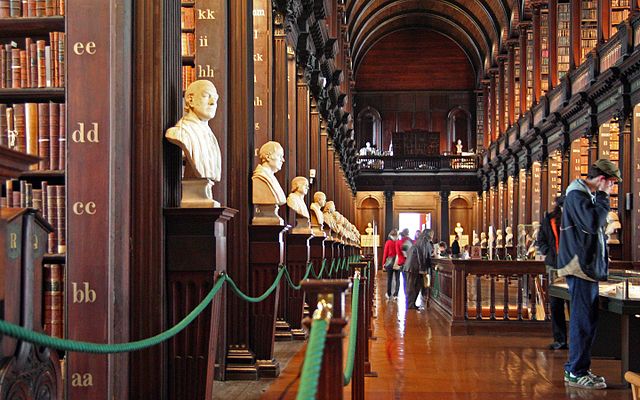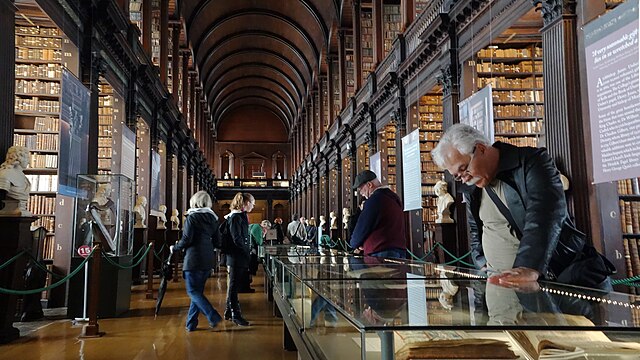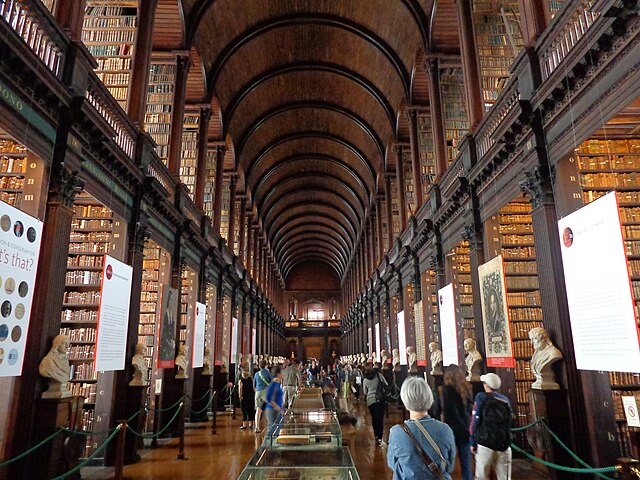Trinity College Library Dublin, Ireland.
As we look to the new year 2015, it may be nice to see what some people who love libraries consider one of the most beautiful libraries in the world.
If you ever plan a trip to Europe during vacation time, it may seem like an odd idea to go to see a library instead of shopping or other typical vacation activities. Yet Trinity College Library Dublin is no ordinary library. It is the library of Trinity College and the University of Dublin, Ireland. It was founded in the year 1592 and its look is so unusual that it may have influenced a Star Wars movie. The Jedi archives of the Jedi Temple in the film Star Wars Episode II: Attack of the Clones looks like the Long Room of the Trinity College Library. The Library owns many treasures, including one of the most admired illuminated manuscripts of the Middle Ages, the Book of Kells.

The Book of Kells
An illuminated manuscript is handwritten and hand-painted, and The Book of Kells which contains the four Gospels of the New Testament along with other texts, was created around the year 800 AD. The Book of Kells is not just old, it also has very big and complex paintings. It is called the Book of Kells because Kells is the name of a place in Ireland where it was stored for several hundred years, in a monastery 40 miles north of Dublin. The Book of Kells is in four volumes, of which two may be seen by tourists. The librarians at Trinity College Library, Dublin turn the pages regularly so that visitors may see different paintings in the book.

Irish students and their library.
In Ireland, students love their library. In 2009, the Trinity Students’ Union staged a 24-hour sit-in to protest cuts in the budget to acquire new books for the library, closure of sections of the library on Sunday, and a plan to reduce services by librarians and staff. The Library’s budget for buying books had decreased by one third and the Library had started closing on Sundays. The students pointed out that other libraries at Irish universities were open an average of 80 hours per week – Trinity was only open 71.5 hours weekly – and the University College Dublin Library was open over 100 hours per week.
The Long Room
An older portion of the Trinity College Library built around 1720 contains a Long Room, so called because it is 65 meters long (213 feet). It is the main room of the Old Library, and houses some 200,000 of the Library’s oldest books. At first, the Long Room had a flat ceiling and only stored books on the ground level. By the 1800s more storage space was needed so in 1860, the roof of the Long Room was extended to allow for the construction of a higher gallery. Part of the impressive decorations are marble sculptures of great thinkers and writers, including the scientist Sir Isaac Newton and the Irish-born author Jonathan Swift (1667-1745), who wrote Gulliver’s Travels. The TU Libraries have several books by and about Jonathan Swift who was a very fine writer, even if he could sometimes be very sarcastic.

Swift had a doctorate in religious studies and hoped to make a career in the church, but his writings were very controversial. You have probably seen one of the movie versions of Gulliver’s Travels which include some feature-length cartoons for children. Although the TU Libraries do not seem to own these adaptations, they tend to turn the story of a traveler who goes to many strange lands – including one where people are very big and another where they are very small – into a children’s science fiction fantasy. Many writers on Swift suggest that he also meant to explore ideas about society, how people treat each other, and similar themes. Swift raises issues such as the importance of science in society, quarrels between religions, the question of whether people are basically good or not. Obviously Gulliver’s Travels is a book which can be enjoyed by adults as well as children.
Perhaps Swift’s work that was most upsetting tried to make British people aware of the problems of starving poor people in Ireland in 1729. Instead of writing a straightforward article or pamphlet, Swift wrote a savagely ironic and satiric essay, A Modest Proposal. In it, he proposed that rich people in England could always buy babies from poor Irish families and cook them for dinner. Naturally Swift did not mean this as a serious suggestion, but wanted to shock the reader into being aware of how people in his time did not think about the problems of the poor. Even today, when people speak of Swiftian satire, they usually mean something biting and even nasty, which can be upsetting to anyone who takes it seriously. If you like to read poetry, Swift was also one of the finest poets of his time, using strong rhyme and meter that are very pleasant to read. The Irish are proud of their writers, even the ones such as Swift who could be disruptive and troublesome. It is fitting that the Trinity College Library Dublin honors this great author. If you ever travel to Dublin on holiday, try to see the marble sculpture in his honor there.

(all images courtesy of Wikimedia Commons).

